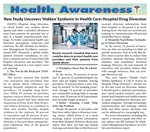

(NAPSI)—Hospital drug diversion, in which health care workers divert opiates and other controlled substances away from patients for personal use or sale, is a largely underdiscussed challenge. To better understand health care diversion perceptions, behaviors and solutions, the BD Institute for Medication Management Excellence commissioned KRC Research, a global public opinion research consultancy, to conduct a national survey of more than 650 hospital executives and providers. The findings, released in a new report, were eye opening.
1. The Not-In-My-Backyard (NIMBY) Effect
The survey showed that health care executives and providers may be in denial about substance use among hospital employees and the prevalence of hospital drug diversion. While 85 percent of providers express concern about diversion, and 50 percent report they have observed suspicious activity, fewer than 20 percent believe diversion is a problem in their own facility. Further, despite evidence to the contrary, 26 percent of executives and 29 percent of providers surveyed believe substance use disorder is less prevalent among hospital employees than in the general population.
2. Workplace Stress May Be a Related Issue
In the survey, 58 percent of nurses and 52 percent of anesthesiologists say their jobs are highly stressful. Among providers, 78 percent know a peer who may be stressed “to the breaking point.” And, though 74 percent of providers are comfortable seeking help to manage stress, only 39 percent of all respondents have actually sought assistance.
3. Better Training Could Help Solve the Problem
Nearly 60 percent of providers said they have either taken a diversion training course, talked about it in a work meeting, and/or received information from their hospital. However, 40 percent report they have not had any formal training, and more than a third have not received diversion information from their hospital or discussed it at work. Among those who had not received any training or communication, 60 percent would like that to change.
4. Hospitals Need Better Technology to Detect Diversion
In the survey, 32 percent of executives say they are spending too little on specific measures, such as tools that deliver more accurate data to reduce false positives, machine learning, advanced analytics, and mandatory diversion training. However, the vast majority of executives and providers believe that, with enough resources, they can mitigate diversion risk.
This new report—“Health Care’s Hidden Epidemic: A Call to Action on Hospital Drug Diversion”—should not be the last word on diversion. Rather, it should spark a national conversation, spur much-needed research, and ultimately lead hospitals and health systems to adopt comprehensive diversion prevention programs. Through technology, communication and training, cultural shifts and other means, diversion risk can be addressed in a meaningful way.
For more information, including the report, a resources guide and other assets, please visit BD Institute for Medication Management Excellence at www.bd.com/diversion-report.
Download high-resolution, print_quality graphic and MS Word document